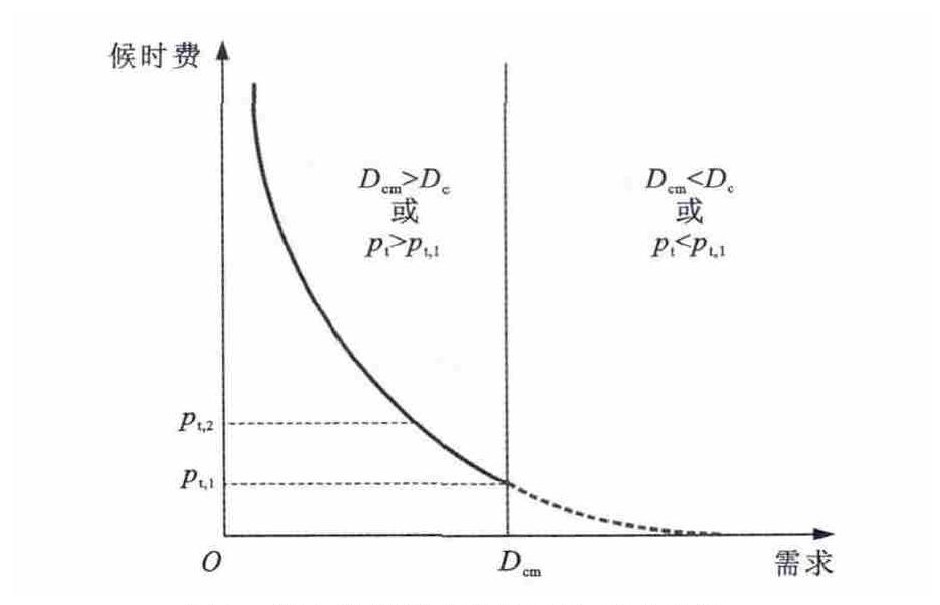Optimal model of taxi waiting time fee under traffic congestion condition
-
摘要: 基于经济学需求理论, 将出租车收入分为起步费、里程费与候时费。以出租车运力为约束条件, 考虑了高峰时段与非高峰时段的出租车收入影响因素, 分析了候时费对出租车需求与收入的影响程度, 构建了交通拥堵环境下出租车候时费优化模型。根据北京市出租车市场的实际状况, 以原有方案、调整方案与提出的方案3种方案进行实例验证。分析结果表明: 当出租车起步费分别为12、14、12元, 单位里程费分别为2.0、2.3、2.0元·km-1, 候时费分别为24.0、55.2、55.2元·h-1时, 出租车收入分别为669.9、504.9、675.9元; 在调整方案下, 出租车需求下降46.1%, 出租车收入下降25%;在提出的方案下, 出租车需求下降18.5%, 出租车收入与原有方案基本保持稳定。基于现有的出租车费用结构, 提出的方案能较好地实现出租车需求与收入的调控目标。北京市的出租车价格改革方案宜稳定或降低起步费与里程费, 提高候时费。Abstract: Based on economics demand theory, taxi income was divided into starting fee, mileage fee and waiting time fee.Taxi capacity was taken as constraint condition, the influence factors of taxi income during peak period and non-peak period were considered, the influence levels of waiting time fee on taxi demand and income were analyzed, and the optimal model of taxi waiting time fee under traffic congestion condition was set up.Based on the actual situation of taxi market in Beijing City, the example verification was carried out by using three schemes including original scheme, adjustment scheme and proposed scheme.Analysis result shows that when the starting fees are 12, 14, 12 yuan, unit mileage fees are 2.0, 2.3, 2.0 yuan·km-1 and waiting time fees are 24.0, 55.2, 55.2 yuan·h-1, taxi incomes are 669.9, 504.9, 675.9 yuan respectively. Under adjustment scheme, taxi demand decreases by 46.1%, and taxi income decreases by 25%. Under the proposed scheme, taxi demand decreases by 18.5%, and taxi income keeps stable level compared with original scheme.According to the exist structure of taxi fee, the adjustment objective of taxi demand and income can be realized by using proposed scheme.In the reformscheme of taxi price in Beijing City, it is suitable to keep or decrease starting fee and mileage fee and increase waiting time fee.
-
Key words:
- transportation economy /
- traffic congestion /
- taxi income /
- taxi demand /
- waiting time fee
-
表 1 出租车市场相关参数
Table 1. Correlation parameters of taxi market

表 2 三种方案结果比较
Table 2. Result comparison of three schemes

-
[1] DOUGLAS G W. Price regulation and optimal service standards[J]. Journal of Transport Economics and Policy, 1972, 6 (2): 116-127. [2] VANY A S. Capacity utilization under alternative regulatory restraints: an analysis of taxi markets[J]. Journal of Political Economy, 1975, 83 (1): 83-94. doi: 10.1086/260307 [3] ALVARO P, FRIDA J. Pricing and regulatory issues in urban transport[R]. Washington DC: Word Bank, 1989. [4] MORISUGI H, ARINTONO S, PARAJULI B P. Fare level and fleet optimization of taxi and bus operation in Yogyakara, Indonesia[J]. Journal of the Eastern Asia Society for Transportation Studies, 1997, 2 (5): 1547-1553. [5] JASON S K, CHUN C. Taxi vacancy rate, fare, and subsidy with maximum social willingness-to-pay under log-linear demand function[J]. Transportation Research Record, 2009 (2111): 90-99. [6] YANG Hai, FUNG C S, WONG K I, et al. Nonlinear pricing of taxi services[J]. Transportation Research Part A: Policy and Practice, 2010, 44 (5): 337-348. doi: 10.1016/j.tra.2010.03.004 [7] AQUILINA M. Quantity de-restriction in the taxi market: results from English case studies[J]. Journal of Transportation Economics and Policy, 2011, 45 (2): 179-195. [8] 卢青, 陈琦. 城市出租车价格管理问题探讨[J]. 交通企业管理, 2012, 27 (8): 22-23. doi: 10.3963/j.issn.1006-8864.2012.8.010LU Qing, CHEN Qi. Analysis of taxi price management[J]. Transportation Enterprise Management, 2012, 27 (8): 22-23. (in Chinese). doi: 10.3963/j.issn.1006-8864.2012.8.010 [9] 顾海兵, 郑杰. 出租车价格管制的经济学剖析[J]. 价格理论与实践, 2010, 30 (3): 16-18. https://www.cnki.com.cn/Article/CJFDTOTAL-HYXY200402012.htmGU Hai-bing, ZHENG Jie. Economics analysis of taxi price system[J]. Price: Theory and Practice, 2010, 30 (3): 16-18. (in Chinese). https://www.cnki.com.cn/Article/CJFDTOTAL-HYXY200402012.htm [10] CHIEN S, GAO Sheng-yan, MEEGODA J N, et al. Fleet size estimation for spreading operation considering road geometry, weather and traffic[J]. Journal of Traffic and Transportation Engineering: English Edition, 2014, 1 (1): 1-12. doi: 10.1016/S2095-7564(15)30084-2 [11] 杨英俊, 赵祥模. 基于出租车运行信息的城市出租车运量投放计划模型[J]. 中国公路学报, 2012, 25 (5): 120-125. doi: 10.3969/j.issn.1001-7372.2012.05.019YANG Ying-jun, ZHAO Xiang-mo. Schedule model of urban taxi quantity based on taxi running information[J]. China Journal of Highway and Transport, 2012, 25 (5): 120-125. (in Chinese). doi: 10.3969/j.issn.1001-7372.2012.05.019 [12] WONG K I, WONG S C, YANG Hai. Modeling urban taxi services in congested road networks with elastic demand[J]. Transportation Research Part B: Methodological, 2001, 35 (9): 819-842. doi: 10.1016/S0191-2615(00)00021-7 [13] 刘科, 沈建军, 杨长虹. 关于城市出租车规划的模型及应用[J]. 数学的实践与认识, 2006, 36 (7): 141-150. doi: 10.3969/j.issn.1000-0984.2006.07.014LIU Ke, SHEN Jian-jun, YANG Chang-hong. Model and application of taxi programming in cities[J]. Mathematics in Practice and Theory, 2006, 36 (7): 141-150. (in Chinese). doi: 10.3969/j.issn.1000-0984.2006.07.014 [14] SCHALLER B. Elasticity for taxicab fares and service availability[J]. Transportation, 1999, 26 (3): 283-297. doi: 10.1023/A:1005185421575 -





 下载:
下载:










